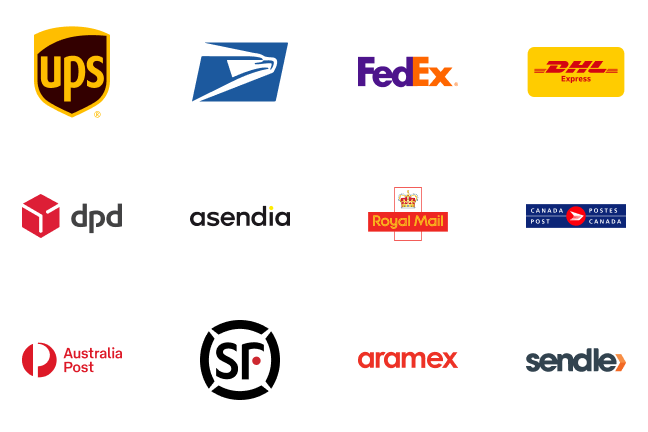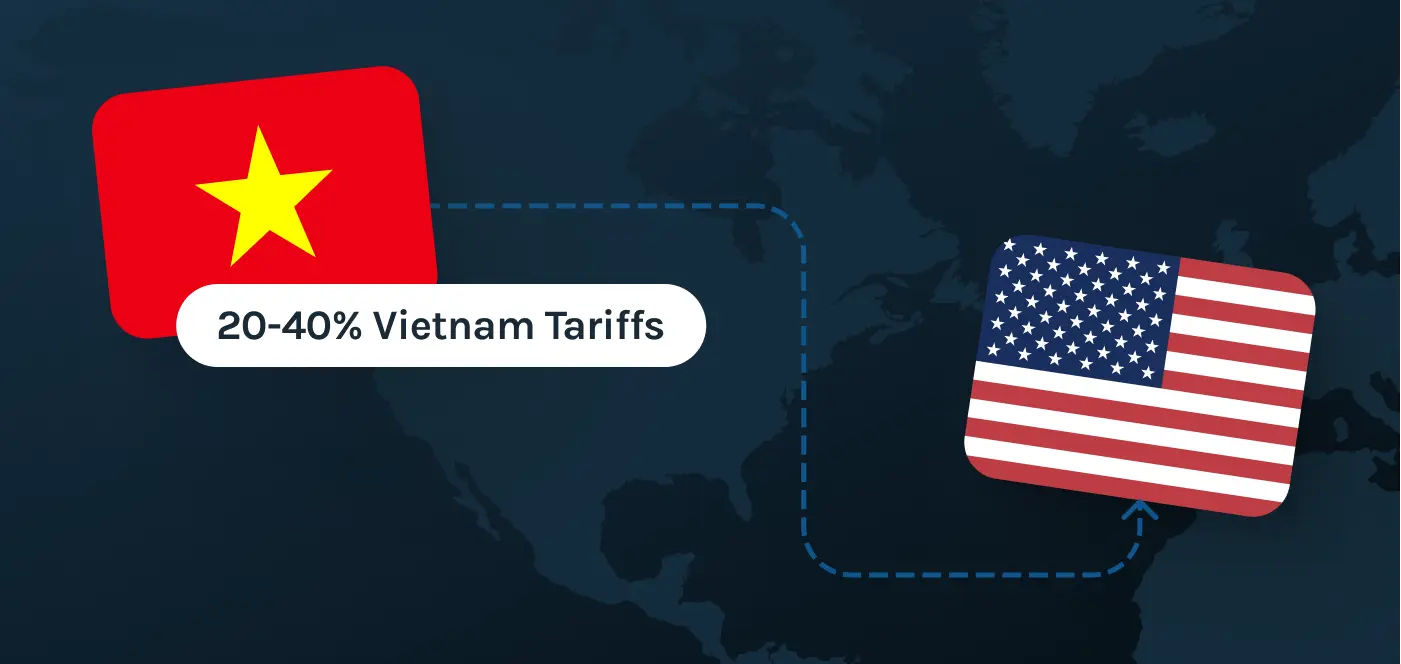Vietnam tariffs in 2025 are reshaping global sourcing strategies. If your eCommerce business relies on Vietnamese imports—like apparel, electronics, furniture, or accessories—this guide will help you understand what’s changing, why it matters, and how to adapt your sourcing and pricing models in response to evolving tariff policy and international trade challenges.
What Are the 2025 Vietnam Tariffs?
In June 2025, the United States Trade Representative (USTR) imposed new tariffs on Vietnamese-made goods. This followed a review process that identified currency manipulation, illegal subsidies, and non-tariff barriers that distorted trade with the United States of America.
As a result, the U.S. introduced a 20% tariff rate on confirmed Vietnamese-origin goods, while goods deemed to be transshipped from third countries through Vietnam face a higher 40% tariff. These duties are in addition to existing import charges and act as reciprocal tariffs responding to what some officials called unfair trade practices. This new tariff rate will be implemented starting from August 1, 2025.
To find out more about the change in tariffs and de minimis rules this year, you can check out this article here. The de minimis rules still applies to Vietnam, which means that shipments under $800 are exempted from tariffs. The main facets of shipping that are likely to be affected by these tariff changes are freight shipments which are bulk orders that have higher value (above $800).
Key impacted categories include:
- Apparel and footwear
- Electronics (especially consumer gadgets)
- Wooden furniture and home goods
- Textiles, bags, and accessories
These tariffs are imposed at the point of entry and apply to all Vietnamese exports to the U.S. in the targeted categories.
Reminder: Tariffs are subject to change, as negotiations are ongoing. It’s important to keep checking for the latest updates and changes in the tariff landscape to make the right decisions for your business.
Why Vietnam? Context Behind the Tariff Decision
Vietnam had become the second-largest trading partner for U.S. importers after China, offering preferential tariffs, low labor costs, and rising manufacturing capacity. Between 2019 and 2024, U.S. imports from this Southeast Asian country surged more than 130% (U.S. Census Bureau), as businesses sought to avoid tariffs on Chinese goods under Section 301.
But:
- U.S. officials claimed Vietnam agreed to trade rules it did not follow, especially regarding intellectual property protection and digital trade.
- Trade imbalances raised concerns over national security, including reliance on critical minerals and tech components.
- In response, the White House introduced new tariffs similar to those launched during the Trump administration.
What Products Are Affected by the Vietnam Tariffs?
The following chart outlines key product groups now subject to higher country-specific tariff rates under the new agreement:
| Product Category |
Tariff Rate on Vietnamese-Origin Goods |
Transshipment Tariff Rate (Goods from Third Countries) |
| Apparel (Men/Women) |
20% |
40% |
| Footwear |
20% |
40% |
| Wooden furniture |
20% |
40% |
| Consumer electronics |
20% |
40% |
| Bags & accessories |
20% |
40% |
This adjustment limits tariff-free access for many technology companies and fashion retailers sourcing from Vietnam.
How Vietnam Tariffs Impact U.S. eCommerce Businesses
If you're a small-to-medium-sized eCommerce business, these changes affect how you sell products, calculate import costs, and compete with other countries that still enjoy zero tariff or low-duty access.
1. Higher landed costs
The new tariffs increase your cost of goods sold (COGS). For example, a $50 jacket now costs $60 after the 20% tariff, reducing your profit margins significantly. However, the de minimis rule still applies to Vietnam, which means that shipments under $800 in value will not be taxed.
2. Inventory delays
Customs processing may slow down as enforcement of origin verification and compliance increases. Importers disputing country of origin or product classification could face shipment holds or re-inspections.
3. Strain on pricing models
Merchants offering free shipping or frequent discounts may need to raise prices, which risks triggering higher prices for customers and potential loss of conversions.
Vietnam Tariffs vs. Tariffs from China, Mexico, and Canada
| Country |
Average Tariff Rate (2025) |
De Minimis Status |
Tariff Type |
| Vietnam |
20% (40% on transshipments) |
Open |
Anti-subsidy/Reciprocal |
| China |
25–100% (varied) |
Closed |
Section 301/Anti-dumping |
| Mexico |
0–5% (USMCA) |
Open |
Standard customs duties |
| Canada |
0–3% (USMCA) |
Open |
Standard customs duties |
Vietnam now mirrors China in tariff complexity and processing time. Mexico and Canada, under USMCA, provide lower tariffs and more stable sourcing options for U.S. retailers.
Logistics Disruptions and Shipping Route Changes
Tariffs are only one part of the cost equation. The resulting trade shifts cause:
- Customs clearance delays: Due to new export controls, origin verification, and document inspections.
- Air freight congestion: Especially on Vietnam–U.S. routes, leading to higher rates.
- Multi-country routing: Some sellers re-export through countries like Thailand or Malaysia to avoid direct Vietnam labeling—but this increases shipping times and complexity.
Step-by-Step: How to Evaluate and Adapt Your Sourcing Strategy
- Review SKUs by origin country: Use your shipping platform or order management system (OMS) to identify which SKUs are made in Vietnam.
- Check updated tariff levels: Visit the Harmonized Tariff Schedule and confirm current rates and compliance requirements.
- Request FOB and CIF pricing from suppliers: Compare total costs from Vietnam against alternatives like India, Mexico, or Brazil.
- Benchmark new suppliers: Explore vendors in Mexico, South Korea, Brazil, or India where trade may involve lower tariffs and better logistics.
- Negotiate Incoterms and payment terms: Consider switching from Delivered Duty Paid (DDP) to FOB or CIF to better control shipping and customs processes.
Step-by-Step: How to Adjust Your Pricing and Margins
- Update your COGS model: Factor in tariffs, brokerage fees, and increased shipping costs.
- Recalculate net margins: Use tools like Easyship to simulate end-to-end costs from Vietnam and alternative sources.
- Revise pricing tiers: Introduce pricing bands or bundle deals to offset tariff-driven price increases.
- Adjust offers and positioning: Highlight non-price values like fast shipping, eco-friendly packaging, or support for American agricultural products.
- Communicate changes transparently: Clearly inform customers about price changes related to global sourcing challenges.
Alternative Sourcing Options Beyond Vietnam
| Country |
Strengths |
Weaknesses |
| Mexico |
USMCA, close proximity, fast shipping |
Higher labor costs |
| India |
Skilled workforce, growing capacity |
Longer lead times |
| Indonesia |
Low labor costs, diverse products |
Weaker infrastructure |
| Cambodia |
Strong textile sector |
Regulatory uncertainty |
| Brazil |
Rich in energy and agricultural products |
Past reliability concerns |
For medical devices, dairy, or energy products, countries with negotiated trade deals might be preferred.
Short-Term and Long-Term Business Strategies
Here are some strategies you can follow to help your business stay profitable during these uncertain times:
Short-Term
- Shift to multi-country sourcing to reduce exposure to Vietnam tariffs.
- Use U.S.-based 3PLs for faster fulfillment. Easyship's network of 3PL fulfillment centers can help with your logistics process.
- Introduce tiered shipping to manage customer cost perception.
- Use Easyship’s tax and duties calculator and multi-carrier software to calculate customs duties and find the cheapest shipping rates.
Long-Term
- Establish nearshoring or joint ventures in Latin America.
- Negotiate contracts with suppliers that allow for pricing buffers against tariff hikes.
- Adopt automated supply chain tools to track tariffs, customs delays, and shipping costs in real time.
- Use platforms like Easyship to maximize operational efficiency and profitability.
Final Takeaways for Small eCommerce Business Owners
- Vietnam is no longer a guaranteed low-cost sourcing hub for U.S. importers.
- Tariffs and trade barriers can shift quickly—keep your sourcing strategy flexible.
- Regularly review all international trade partners and supply chains.
- Shipping and customs platforms like Easyship simplify navigating tariff rules and calculating landed costs.
How Tariff Policy Trends May Change in 2026
Ongoing public comments and debates suggest trade policies may evolve further:
- Possible new trade deals with South Korea or the European Union.
- Efforts to reduce non-tariff barriers on digital trade and electronic payment services.
- Increased scrutiny over illegal deforestation and supply chain transparency in Southeast Asia.
Staying informed and agile is essential for any business with cross-border supply chains.
Ready to simplify and save on shipping?
Easyship is here to help.
Easyship helps eCommerce sellers stay profitable in a changing trade environment. With reciprocal tariffs, customs duties, and new rules for cross-border orders, our free shipping tools and smart dashboard are built to help you ship smarter and sell globally—without the stress.
FAQ: Vietnam Tariffs 2025 for U.S. eCommerce Sellers
When did the new Vietnam tariffs take effect?
The new tariffs were negotiated in June 2025 following a USTR review citing trade imbalances and unfair practices. Currently, the baseline 10% tariff is effective, extending until the 1st of August.
What is the new tariff rate on Vietnamese goods?
Most targeted products now face a 10% tariff until the 1st of August, while transshipped goods through Vietnam are taxed at 40%.
What types of products are affected?
Key impacted categories include apparel, footwear, electronics, wooden furniture, textiles, and accessories.
How can I tell if my goods are transshipped?
Transshipment typically means goods were manufactured in a third country but routed through Vietnam to mask their origin. U.S. Customs will investigate suspicious patterns or incomplete documentation.
What tools can I use to calculate the new costs?
Platforms like Easyship offer landed cost calculators, customs duty estimators, and multi-carrier comparisons to help you assess your shipping and tax exposure.
Should I stop sourcing from Vietnam entirely?
Not necessarily. It’s wise to diversify your sourcing by comparing total landed costs and logistics timelines from other countries like Mexico, India, or Indonesia.
Can I pass the extra cost to my customers?
Yes, but with caution. Consider tiered pricing, bundle deals, or highlighting added value like sustainability or faster delivery to maintain conversion rates.
Will these tariffs remain in place beyond 2025?
Uncertain. Trade policy is dynamic—upcoming negotiations or 2026 regulatory reviews could revise tariff rules. Stay updated through USTR announcements and trade advisories.















































.svg)
.svg)






.avif)
.avif)

.avif)
.avif)


.avif)


.avif)










.avif)
.avif)



.avif)
.avif)


.avif)
.avif)


.avif)











.svg)









.webp)